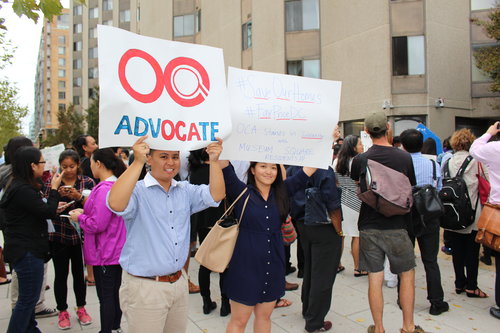By Jennie L. Ilustre
Two recent developments have raised the stakes on the controversial family separation issue for the Trump Administration and advocates who want to see migrant children reunited with their parents.
One is the subpoena expected to be issued in the 115th US Congress by the House Oversight Committee on three Trump Administration officials. The subpoena calls for documents related to the Administration’s migrant family separation policy. Launched in April last year, the policy was reversed by President Trump with an executive order on June 20, 2018.
Another is a legal action by the American Civil Liberties Union (ACLU), as reported by the New York Times. ACLU asked a judge to order the Administration to account for all migrant children separated from their parents. The ACLU lawyers point to an inspector general’s official report last January that “thousands” more may have been separated than the government has reported. Last year, the Administration said that over 2,800 migrant children had been separated from their families.
In May 2018, the Trump Administration launched a zero-tolerance policy to stem the flow of undocumented migrants entering the US. Enforced at the US-Mexico border, the policy resulted in the separation of over 2,000 children, teenagers and even infants from their parents over a six-week period. The policy was reversed, as a result of a huge public outcry from Democratic, Republican and Independent voters and officials. The children were placed in detention centers.
OCA-Asian Pacific American Advocates urged the US Congress to pass a stand-alone immigration legislation keeping the migrant families together.
The issue strikes a chord in the community. OCA-APAA pointed out: “The Asian American and Pacific Islander communities understand not only what it’s like to be detained, like with Angel Island or the World War II internment camps, but also what it is like to seek asylum in another country. These policies irreparably traumatize young children seeking safety in a new country.”
Reuniting Families
Most Republican voters and lawmakers focus on fixing the nation’s broken immigration system through a strong border security. But there are some Republicans who seek a balanced approach. A Politico news story recently reported that Congressman Greg Walden, Republican from Oregon, said: “While I support strong enforcement of the nation’s borders, I want to make something very clear: I support keeping families together.”
A divided Congress, with a Democratic House and a Republican Senate, is not likely to pass legislation on the issue. But community advocacy groups such as the OCA-Asian Pacific American Advocates and Asian American civil rights leader Gregory A. Cendana emphasize the need for vigilant action towards this goal.
Cendana is the former Executive Director of the AFL-CIO Asia Pacific Labor Alliance (APALA). Currently, he is the President and Co-Founder of Can’t Stop! Won’t Stop! Consulting. He said on February 22 that family separation is one of the nation’s real crises that call for vigilance and sustained advocacy. “We must remain vigilant and continue to shine a light on actual crises such as the separation of families and children, increased funding of Trump’s deportation force and the further criminalization of people of color.”
Here are 5 important things to know about the family separation issue.
1. The House Oversight Committee Chairman of the 115th Congress wants to investigate the family separation policy.
In the 115th Congress which began last January, House Oversight Committee Chairman Elijah Cummings (D) scheduled a February vote in the committee, where Democrats have a 24-18 majority, to issue subpoenas to Homeland Security Secretary Kirstjen Nielsen, Attorney General William Barr, and Health and Human Services Secretary Alex Azar, according to a Reuters news report.
The report added that top Oversight Committee Republican Jim Jordan wrote Cummings a letter on February 22, saying a vote on a subpoena was premature, noting that the three departments have been working in an expeditious manner to provide documents and information to the Committee.
2. Abuses have been reported in detention centers.
Reuniting the children with their parents or other family members who are US citizens has gained only in urgency with each bit of news: abuses to girls and boys in detention centers, force-feeding those going on hunger strikes as a form of protest, and toddlers being among those detained. The news is made more alarming with audiotapes of toddlers crying and videos secretly taped by concerned staff on the cage-like conditions of some shelters, and shared with the Mainstream Media.
3. Reuniting children with their parents is a challenging task.
Adequate records of separated parents and children are a major concern, according to media reports. John Harlow, a resident physician at the LAC+USC Healthcare Network in Los Angeles,wrote in a 2018 CNN opinion that “questions remain as to whether reunification is even possible in many cases…This week the Department of Justice will likely fail to comply with a court order mandating the reunification of all children under five years of age with their parents…”
4. Medical experts say the traumatic detention experience will cause long-term health damage to the children, as well as to their families.
The family separation policy threatens the mental and physical health of both the children and the parents, Science Alert website noted in the midst of the controversy. Experts warned that it could cause “long-term damage to children’s brains,” according to a Washington Post report. A Scientific American article quoted medical experts who said separating families may cause “lifelong health damage.”
The detention experience is aggravated by a prior exposure to mortal danger. Attorney Arnedo S. Valera, executive director of the Migrant Heritage Commission (MHC) said, “Many of these parents and their children are fleeing their countries in Central America in grave fear for their lives because of gang violence and drug cartel’s atrocious criminal activities. They are seeking asylum and refugee status in the US.”
Valera, an ordained minister, renewed appeals to balance border security concerns with compassion. “Taking children, including infants, away from their mothers and fathers is cruel and un-American. We are a compassionate country and we should deal with this immigration issue in the most humane and compassionate manner,” he said.
5. The Asian American and Pacific Islander communities understand this issue based on two tragic policies of the past, and on the WWII policy, a Japanese American lawmaker and an American President made things right.
At the height of the controversy, OCA-Asian Pacific American Advocates issued a media release, citing history and urging action from the President and Congress: “The policy harkens back to the United States’ detention policies towards Chinese and other Asian immigrants on Angel Island in the early twentieth century, as a result of the passage of the Chinese Exclusion Act, who were fleeing violence and seeking economic opportunities,” OCA-APAA pointed out. It also recalled the internment of Americans of Japanese ancestry during WWII.
One of the reasons America is a great country is that it acknowledges mistakes of the past and makes amends. During World War II, after Japan bombed Pearl Harbor, President Franklin D. Roosevelt ordered the internment of 120,000 Japanese Americans to war relocation camps. The internment camps were just makeshift barracks, according to a news report by the National Public Radio (NPR), with families and children cramped together behind barbed wires.
In February this year, the nation marked the 25th anniversary of the Civil Liberties Act, which was sponsored by Congressman Norman Y. Mineta. In 1988, President Reagan signed the bill into law. The legislation offered a formal apology and compensated each surviving victim in the amount of $20,000. The executive order and the legislation documents were exhibited at the National Archives during the 25th anniversary, according to the NPR report.
President Reagan delivered remarks with a powerful message at the signing ceremony: “We reaffirm our commitment as a nation to equal justice under the law.”
Remarked Reagan at the 1988 ceremony: “We gather here today to right a grave wrong. More than 40 years ago, shortly after the bombing of Pearl Harbor, 120,000 persons of Japanese ancestry living in the United States were forcibly removed from their homes and placed in makeshift internment camps. This action was taken without trial, without jury. It was based solely on race, for these 120,000 were Americans of Japanese descent.
“…The legislation that I am about to sign provides for a restitution payment to each of the 60,000 surviving Japanese Americans of the 120,000 who were relocated or detained. Yet, no payment can make up for those lost years. So, what is most important in this bill has less to do with property than with honor. For here, we admit a wrong; here, we reaffirm our commitment as a nation to equal justice under the law.”
 Asian Fortune Your source for all things Asian American
Asian Fortune Your source for all things Asian American




